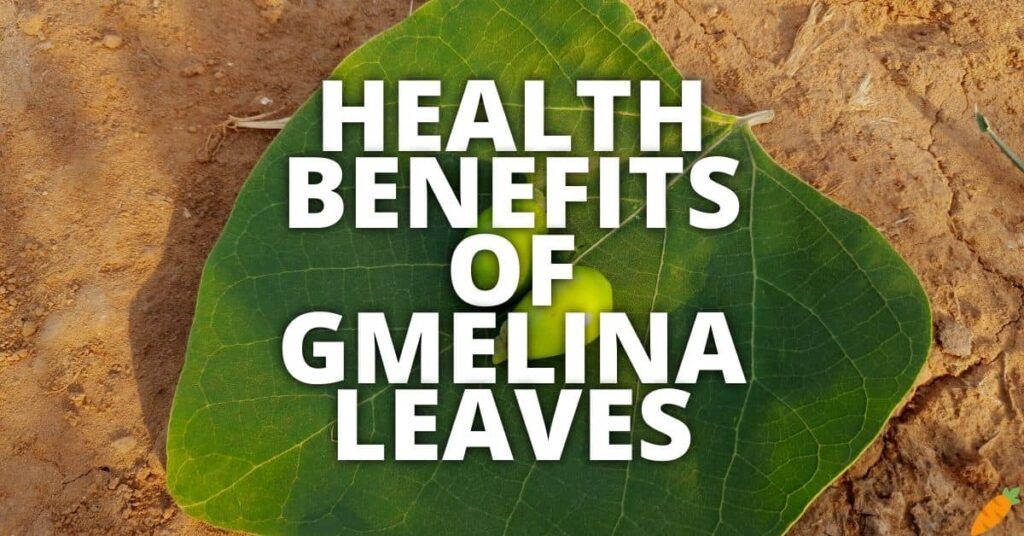Gmelina leaves come from the Gmelina arborea tree, a plant widely found in Southeast Asia and valued for many uses.
People have long used these leaves in traditional medicine to help with health problems such as fever, cough, and skin conditions.
Modern studies are starting to look deeper into the potential health benefits of gmelina leaves, finding that they may contain helpful compounds like flavonoids, alkaloids, and tannins.
These compounds are believed to support the body in different ways, from reducing inflammation to protecting the liver.
Let’s explore what science and tradition say about how Gmelina leaves may contribute to better health.
1. How People Commonly Use Gmelina Leaves
Gmelina leaves can be prepared in many ways, and the method often depends on the tradition or health need being addressed.
One of the most common practices is boiling the leaves in water to make tea or a stronger decoction that people drink in small amounts.
This preparation is sometimes used in Ayurvedic medicine to support general wellness and aid digestion.
Some traditional healers also value the tea for its mild diuretic effect, which helps the body release extra fluid and cleanse the system.
In many households, the same tea is carefully taken to ease constipation or reduce discomfort linked to an upset stomach.
For external purposes, the leaves can be crushed into a paste and applied directly to the skin as a poultice to reduce swelling or soothe a burning sensation from minor injuries.
The leaves may also be soaked in water and used as a wash to clean skin irritations or small infections.
In some cultures, gmelina leaves are considered a restorative remedy that helps people regain energy and recover from weakness or emaciation.
Because of this belief, they are sometimes used as a simple home treatment to rejuvenate both the body and the mind.
It is worth noting that the gmelina plant itself is a large deciduous tree, and its leaves are only one of the parts used for traditional healing.
Different methods of preparation may change the strength of the remedy and the way it affects the body.
For this reason, care and guidance are important when deciding how to prepare and use gmelina leaves for health benefits.
📙 Potential Health Benefits of Awolowo Leaf
2. May Have Anti-Inflammatory Properties (My Favorite Potential Health Benefit Of Gmelina Leaves)
Gmelina leaves have significant medicinal value thanks to their bioactive compounds, such as flavonoids, terpenoids, and phenolic acids.
These compounds have anti-inflammatory effects that can help reduce inflammation in the body.
Inflammation is a normal immune system response to injury, infection, or damage.
But inflammation that lasts for a long time can cause long-term diseases like arthritis, asthma, allergies, and heart disease.
By reducing redness and swelling, gmelina leaves may help prevent or ease the symptoms of these conditions.
For instance, studies have shown that gmelina leaves can reduce joint pain and improve joint function in people with arthritis.
Additionally, gmelina leaves may help to reduce inflammation in the airways, making it easier for people with asthma to breathe.
They may also help to reduce an allergic reaction and relieve allergy symptoms like sneezing, a runny nose, and itchy eyes.
It’s important to note that while Gmelina leaves have potential medicinal value, they should not be used as a substitute for traditional medical treatment.
If you have a medical condition or are taking medication, it’s important to talk with your doctor before using gmelina leaves or any other natural remedy.
📙 Potential Health Benefits of Dog Blood Bush
3. Gmelina Leaves May Contain Antioxidants
Gmelina is recognized as a medicinal plant with strong antioxidant activity found in its leaves, including flavonoids, phenolic acids, and carotenoids.
Free radicals are unstable molecules that can damage cells, and over time, this damage may contribute to cancer, heart disease, and Alzheimer’s disease.
Antioxidants are important because they neutralize free radicals and lower the risk of harmful cellular changes.
Among the many phytochemicals in gmelina leaves, flavonoids are especially powerful and exist in high amounts.
Other important antioxidant compounds include glycoside forms, which help regulate how these protective substances work in the body.
Research has also identified gmelinol, a compound in gmelina, that may add to its overall antioxidant effects.
Another related substance, gummadiol, has been noted as part of the plant’s chemical profile and may play a role in reducing oxidative stress.
Together, these constituents may lower inflammation and protect cells from long-term damage linked to chronic illness.
By reducing cholesterol oxidation, the antioxidants in gmelina leaves may help prevent artery problems that lead to heart disease.
They may also support brain health by easing oxidative stress, which is a factor in the development of Alzheimer’s disease.
📙 Potential Health Benefits of Djeka Leaves
4. May Have Antimicrobial Qualities
Gmelina leaves have great medicinal value due to the presence of bioactive compounds such as alkaloids, flavonoids, and tannins.
The antimicrobial properties of the leaves come from these compounds, which make the leaves effective against bacterial, viral, and fungal infections.
Bacterial infections can cause skin infections, pneumonia, and urinary tract infections, among other health problems.
Gmelina leaves are effective against common bacterial strains like Staphylococcus aureus and Escherichia coli.
Also, the leaves of Gmelina can be used to treat viral illnesses like the common cold, flu, and herpes.
Researchers have found that the antiviral properties of gmelina leaves work against many different viruses, including the herpes simplex virus and the human immunodeficiency virus (HIV).
Fungal infections such as athlete’s foot and ringworm can also be treated with gmelina leaves.
The antifungal properties of gmelina leaves are effective against several types of fungi, including Candida albicans and Aspergillus niger.
📙 Potential Health Benefits of Avarampoo

5. Gmelina Leaves May Help Lower A Fever
Gmelina leaves have a long history of use as a natural tonic and remedy for fever in many parts of Asia.
The leaves contain compounds that fight inflammation and encourage sweating, which helps the body cool down during a fever.
Fever is a common reaction to infections, and traditional healers in Thailand have used gmelina leaves as part of herbal practices to ease this condition.
Scientific studies also support these traditional uses, showing that extracts from the leaves lowered fever in animal tests.
In one study, rats with fever that were treated with gmelina leaf extract showed a clear drop in body temperature.
The plant is not limited to its leaves, since the bark has also been used in some traditional remedies for managing heat and discomfort.
By lowering inflammation in the body, gmelina leaves may also help reduce other symptoms that come with fever, such as headaches and tiredness.
These findings suggest that gmelina may provide gentle support for fever care, although more studies in humans are needed to confirm its effects.
📙 Potential Health Benefits of Water Snowflake
6. May Have Antidiabetic Properties
The fact that flavonoids, alkaloids, and terpenoids are present in gmelina leaves is what gives them their antidiabetic effects.
Researchers have found that these compounds help lower blood sugar by making cells more sensitive to insulin and making cells take in more glucose.
Diabetes is a long-term disease in which the body can’t control the amount of glucose in the blood properly.
This can lead to a range of health problems, including nerve damage, kidney damage, and cardiovascular disease.
Managing blood glucose levels is an important part of diabetes treatment, and gmelina leaves may be a useful natural remedy for people with diabetes.
Several studies have found that gmelina leaves can help lower blood glucose levels in both animals and humans.
In one study, rats with diabetes were given an extract of gmelina leaves, which caused their blood glucose levels to drop significantly.
Another study found that gmelina leaves can help reduce insulin resistance, which is a key feature of type 2 diabetes.
📙 Potential Health Benefits of Parrot Feather
7. Gmelina Arborea Leaves May Help With Ulcers
The fact that flavonoids, alkaloids, and tannins are all found in gmelina leaves is what gives them their anti-ulcer properties.
These compounds have been found to help protect the lining of the stomach from damage and reduce inflammation in the stomach.
Stomach ulcers are a common condition that can cause abdominal pain, bloating, and other digestive symptoms.
Most of the time, multiple factors, such as a bacterial infection, prolonged use of nonsteroidal anti-inflammatory drugs (NSAIDs), or stress, are to blame.
Scientists have found that gmelina leaves can help heal stomach ulcers and may be a good natural way to prevent or treat stomach ulcers.
In one study, rats were given an extract of gmelina leaves, which made the number and severity of their stomach ulcers go down a lot.
Another study found that gmelina leaves can help reduce inflammation in the stomach, which can contribute to the development of ulcers.
The ability of Gmelina leaves to keep the stomach lining from getting hurt could also help prevent or treat stomach ulcers.
The chemicals in gmelina leaves can help strengthen the mucous layer that lines the stomach, protecting it from damage from stomach acid and other irritants.
📙 Potential Health Benefits of Jewels of Opar
8. May Have Anti-Anxiety Qualities
Gmelina leaves may support mental well-being because they contain bioactive compounds such as flavonoids and terpenoids.
These natural compounds have been studied for their calming effects on the nervous system, which may help reduce restlessness and unease.
Anxiety often shows up not only in the mind but also in the body, with signs like a rapid heartbeat, sweating, or trembling.
When these symptoms continue, they can interfere with daily activities and lower overall quality of life.
Researchers exploring traditional medicine, including Ayurveda, have noted that plants like gmelina may play a role in easing stress-related concerns.
One animal study found that rats given gmelina leaf extract showed lower signs of anxiety compared to untreated rats.
Another study suggested that these leaves may lower inflammation and oxidative stress in the brain, two factors linked to mood disorders.
By lowering these harmful processes, gmelina leaves may help the brain return to a healthier state of balance.
Traditional healers have also used gmelina leaves to calm the mind and rejuvenate energy in people who feel worn out from stress.
This possible ability to rejuvenate both the body and mind is part of why Gmelina continues to draw interest in natural health research.
Although findings are encouraging, most studies so far have been in animals, and more human research is still needed.
For now, gmelina leaves may be seen as a promising but not yet proven natural option for easing anxiety.
📙 Potential Health Benefits of Lemongrass and Ginger
9. This Medicinal Herb May Have Pain-Relieving Properties
The leaves of Gmelina have pain-relieving properties because they contain bioactive compounds like flavonoids and terpenoids.
These compounds have been found to have analgesic or pain-relieving effects on the body.
Pain is a common symptom of many conditions, including arthritis, back pain, and headaches.
Pain management is an important part of treating these conditions, and gmelina leaves may be a good natural way to help people feel better.
Several studies have found that gmelina leaves can help reduce pain levels in both animals and humans.
In one study, mice were given an extract of gmelina leaves, which helped them feel less pain.
Another study found that gmelina leaves can help reduce pain associated with osteoarthritis.
The fact that Gmelina leaves can ease pain may be because they can reduce inflammation in the body.
Inflammation is a key component of many types of pain, and reducing inflammation can help to alleviate pain.
📙 Potentially Improving Wellness with Various Herbs
10. May Help Heal Wounds
The leaves of the gmelina plant may support wound healing because they contain many helpful compounds, including flavonoids and tannins.
These natural substances are considered important phytochemical agents that can lower inflammation and support recovery.
Researchers have found that such compounds help the body control swelling and encourage the growth of new tissue at the wound site.
This process is important because it can speed up healing and reduce the chance of infection.
Wounds, burns, and other skin injuries often heal slowly and may leave visible scars if not treated properly.
Using gmelina leaves as a poultice or wash may help manage these concerns while the skin repairs itself.
In studies with animals, Gmelina extracts have been shown to close wounds faster than untreated skin.
One study noted that rats treated with the extract developed stronger tissue and healed in a shorter period of time.
Another study observed that gmelina leaves promoted the growth of skin cells, which is a key step in wound recovery.
The plant also appears to help increase collagen production, which gives skin structure and flexibility.
Collagen acts as an important constituent of healthy skin and plays a central role in reducing scar formation.
Some researchers believe that lignan compounds found in gmelina may also play a part in protecting skin tissue during the healing process.
Because of these combined effects, gmelina leaves are considered by many to be a useful natural option for supporting wound care.
Even so, more human studies are needed before Gmelina can be confirmed as a safe and reliable treatment for wounds.
📙 Phenomenal Potential Health Improvements
11. Gmelina Leaves May Have Hepatoprotective Properties
The ability of Gmelina leaves to protect the liver is linked to their bioactive compounds, especially flavonoids and tannins.
These natural substances act as antioxidants and anti-inflammatory agents that may shield the liver from harmful changes.
The liver is a vital organ that removes toxins from the blood, produces bile to support digestion, and stores important nutrients.
Damage to the liver can occur from alcohol use, viral infections, or long-term use of certain medicines.
In botanical studies, Gmelina has been recognized not only for its leaves but also for other parts of the plant, such as the bark and fruit, which are sometimes explored for their medicinal value.
Animal studies provide evidence that Gmelina leaf extracts lower levels of liver enzymes, which are often high when the liver is injured.
One experiment in rats showed that leaf extracts reduced both swelling and tissue damage in the liver.
Another study reported that gmelina leaves lessened oxidative stress in the liver, which is a major factor in the development of chronic disease.
By controlling inflammation and oxidative stress, the leaves may lower the risk of liver conditions such as hepatitis or cirrhosis.
Researchers believe that these protective effects come from the combined action of several compounds rather than a single chemical.
Although more human studies are still needed, the results so far suggest that gmelina leaves could be a helpful natural option to support liver health.
💡 Conclusion
Gmelina leaves contain natural compounds that may support health in many ways.
Research shows they could reduce inflammation, fight infections, lower blood sugar, and even protect the liver.
They may also help with pain, ulcers, anxiety, and wound healing, but more studies are still needed to confirm these effects.
While the potential health benefits of gmelina leaves are promising, they should be used with caution and never as a replacement for medical treatment.
Talking with a healthcare professional before using them is the best way to ensure safe and effective use.
⛑️ Safety First
While Gmelina leaves (Gmelina arborea) have a range of potential health benefits, it’s important to remember that they may not be suitable for everyone.
As with any natural remedy, it’s always a good idea to consult with a healthcare provider before using gmelina leaves.
When using gmelina leaves, it’s especially important to be careful if you are pregnant or breastfeeding, because there hasn’t been enough research to find out if they are safe for these groups.
Also, you shouldn’t use gmelina leaves if you know you’re allergic to plants in the Lamiaceae family, like mint, basil, or rosemary.
It’s also worth noting that while Gmelina leaves may offer health benefits, they should not be used as a substitute for traditional medical treatment.
If you have a medical condition or are taking medication, it’s important to talk with your doctor before using gmelina leaves or any other natural remedy.
⚠️ Content Disclaimer
This article is for general information only and should not be taken as medical advice.
The potential benefits of gmelina leaves are still being studied, and results may vary for each person.
Always talk to a doctor or other healthcare professional before trying any herbal remedies.
You may also treat this article for entertainment purposes and not as a guide for treatment.
The author is not responsible for how this information is used.
❓ FAQs
1. What are Gmelina leaves used for in traditional medicine?
Gmelina leaves have been used for fever, cough, skin problems, and wound healing.
They are also sometimes used to reduce pain, ease stomach issues, and support liver health.
2. Can I drink gmelina leaf tea every day?
There is no clear scientific guideline on safe daily use.
Drinking it once in a while may be fine for healthy people, but using it every day without medical advice could cause unwanted effects.
3. Are Gmelina leaves safe for pregnant or breastfeeding women?
There is not enough research to know if gmelina leaves are safe during pregnancy or breastfeeding.
It is best to avoid them and talk to a doctor first.
4. Do Gmelina leaves have side effects?
Possible side effects may include stomach upset, allergic reactions, or interactions with medicines for blood sugar or blood pressure.
These effects can vary from person to person.
5. Where can I find gmelina leaves?
Gmelina trees grow in many parts of Southeast Asia, including the Philippines and India.
The leaves may be found fresh from the tree, sold in local markets, or prepared as herbal products in some health stores.

